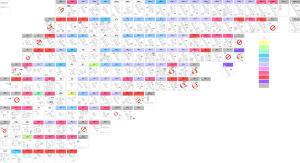This application of the Cordus theory offers a descriptive solution for the relative lifetimes of all the nuclides of Hydrogen to Neon.
More specifically, the theory is able to explain why any one nuclide is stable, unstable, or non-existent. Consequently the theory also explains the drip lines, which are the margins of stability to the table of nuclides. It also explains the gaps in the series and sudden changes in stability across a series. This is achieved by identifying a unique set of rules -a mechanics- for the nuclear polymer. This is based, as with all the rest of the Cordus theory, on a non-local hidden-variable (NLHV) design.
The chart of the nuclides as per the Cordus theory is shown below.
This is a large diagram and may look blank: you will need to pan and zoom to see it. The paper containing this diagram has been submitted to a journal for peer-review. A copy is available on the vixra physics archive.
This theory also explains several other trends in the table of nuclides, which we may discuss another time. Other theories, including quantum chromodynamics (QCD), binding energy, shell model, liquid drop model, and semi-empirical mass formula (SEMF) can explain some of the features of the table of nuclides, but tend to be limited to mathematical representations of binding energy, with little real explanatory power. In contrast this Cordus theory offers explanations where these other theories are at a loss.
So it appears that the nuclide landscape may be explained by morphological considerations based on a NLHV design.
Related articles
- Explaining the Nuclides (cordus.wordpress.com)
- Here is a really useful chart of the nuclides: https://www-nds.iaea.org/relnsd/vcharthtml/VChartHTML.html
- Paper version one Pons DJ, Pons AD, Pons AJ. (2013) Internal structure and assembly mechanics of the nucleus: Nuclides of hydrogen to neon, http://vixra.org/abs/1310.0172
- Update 29/11/2013: Published as Pons, D. J., Pons, A. D., & Pons, A. J. (2013). Explanation of the Table of Nuclides: Qualitative nuclear mechanics from a NLHV design. Applied Physics Research, 5(6), 145-174. doi: http://dx.doi.org/10.5539/apr.v5n6p145
